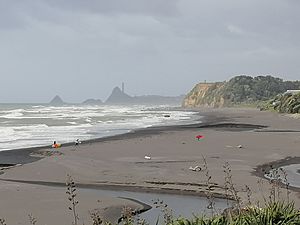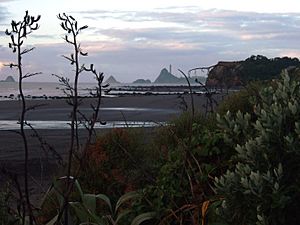Ōakura facts for kids
Quick facts for kids
Ōakura
|
|
|---|---|

A view of Ōakura Beach looking toward New Plymouth
|
|
| Country | New Zealand |
| Region | Taranaki Region |
| Territorial authority | New Plymouth District |
| Ward |
|
| Community | Kaitake Community |
| Electorates |
|
| Area | |
| • Total | 1.68 km2 (0.65 sq mi) |
| Population
(June 2023)
|
|
| • Total | 1,730 |
| • Density | 1,030/km2 (2,667/sq mi) |
| Time zone | UTC+12 (NZST) |
| • Summer (DST) | UTC+13 (NZDT) |
| Postcode(s) |
4314
|
| Area code(s) | 06 |
Ōakura is a small town in the New Plymouth District in Taranaki, New Zealand. It is located on State Highway 45. This highway is about 15 kilometers southwest of New Plymouth. The town of Ōkato is 12 kilometers further southwest.
The Oakura River flows past Ōakura and into the North Taranaki Bight. To the south of the town is the Kaitake Range. This range is part of Egmont National Park.
A local publication called The Oakura Messenger started in October 2000. It was delivered to homes every month. In June 2020, its name changed to the Oakura Post.
On July 5, 2007, a tornado hit the town. It caused damage to about 60 houses.
Ōakura is well known for its beautiful beach, called Ōakura Beach. In 2007, it became one of the first beaches in Oceania to get a Blue Flag award. This award means the beach meets high standards for water quality, safety, and environmental management. Ōakura Beach has kept its Blue Flag status since then.
Contents
About the People of Ōakura
Ōakura covers an area of 1.68 square kilometers. In 2018, the estimated population was about 1,539 people. This means there are about 916 people living in each square kilometer.
The population of Ōakura has been growing steadily. In 2006, there were 1,377 people. By 2013, it grew to 1,437 people. In 2018, the population reached 1,539. This shows an increase of 102 people since 2013.
In 2018, there were 558 households in Ōakura. The number of males and females was almost equal. The average age of people living in Ōakura was 41.7 years.
Most people in Ōakura identify as European or Pākehā, making up about 93.8% of the population. About 10.3% identify as Māori. Smaller groups include Pacific peoples and Asian people.
Many people in Ōakura (57.5%) said they had no religious belief. About 33.7% were Christian. A small number of people followed other religions like Hinduism, Islam, or Buddhism.
A Look at Ōakura's Past
The Ōakura River and the town itself were named after an important female ancestor. Her name was Akura-matapū, and she arrived on the Kurahaupō canoe. The original name of the river was Ōakura-matapu, which means "Belonging to Akura-matapū."
The Ngāti Tairi hapū (a smaller group within a Māori tribe) has strong ties to Ōakura. They are part of the larger Ngā Mahanga a Tairi group. Both Ngāti Tairi and Ngā Mahanga a Tairi belong to the Taranaki tribe. The Ngāti Tairi hapū still has rights to the land through the Ōakura Pā. This is a traditional Māori meeting place located by the Ōakura River. People have lived in the Ōakura area for hundreds of years.
In 1860, the First Taranaki War began. Ngāti Tairi, as part of the Taranaki tribe, joined in fighting against the British. The nearby Tapuae ridge was a place where many conflicts happened.
In 1863, before the Second Taranaki War started, Governor George Grey built forts around Ōakura. These forts were for British troops to protect European settlers in New Plymouth. They also served as a base to take back Tataraimaka. On May 4, 1863, about 40 Māori warriors attacked a small group of soldiers. This event, where nine out of ten soldiers were killed, caused the Second Taranaki War to begin again.
Things to Do in Ōakura
Ōakura's main street is called South Road, also known as Surf Highway 45. Most of the local shops and services are found here.
Besides its famous beach, Ōakura has a popular music venue called Butlers Reef. Many well-known New Zealand and international musicians have performed here. These include Dave Dobbyn, Trinity Roots, Gin Wigmore, and Jimmy Barnes.
The town also has three parks: Matekai, Corbett, and the Shearer Reserve. Just a short drive southwest is Lucy's Gully. This is a beautiful spot in the Kaitake ranges.
If you like jewelry, Ringcraft Moana is a business that makes jewelry. It has a showroom, a garden, and a large collection of abalone pearls. The Wavehaven, located on Surf Highway 45 south of Ōakura, offers places to stay and easy access to surfing beaches.
Once a year, artists in Ōakura open their studios to the public. This event is called the Ōakura Arts Trail. You can find more information about it online.
Marae and Historic Sites
The local Ōakura or Okorotua marae has a meeting house called Moana Kaurai. This marae belongs to the Ngāti Tairi hapū of the Taranaki Māori tribe.
Koru Pā is a historic reserve and a traditional Māori fortified village, called a pā. It is located about 3 kilometers southeast of Ōakura. It is believed to be one of the first Māori settlements in Taranaki. Māori traditions suggest it might have been built as early as 1300 AD by Ngā Mahanga a Tairi.
Education in Ōakura
Ōakura School is a school for students in years 1 to 8. It is a coeducational school, meaning both boys and girls attend. The school was founded in 1866. As of November 2023, it has about 276 students.
Famous People from Ōakura
- Ruhira Matekai, also known as Lucy Stevens, was a well-known Māori woman who lived in Ōakura in the 1800s. Lucy's Gully and Matekai Park are named after her.
- Professional surfer Paige Hareb grew up in Ōakura.


